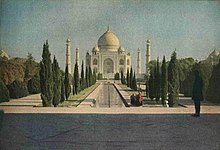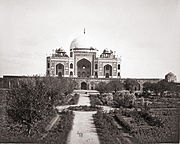Effects of the storage conditions on the stability of natural and synthetic cannabis in biological matrices for forensic toxicology analysis: An update from the literature
Contents

Photography in India refers to both historical as well as to contemporary photographs taken in modern-day India.
Photography was introduced in India by the British in the early 19th century. The earliest photographers were patronized by the British government and the rulers of the princely states.
Colonial period

Photography was introduced in India by the British in the early 19th century.[1] The concept of photography spread to India at a fast pace after the invention, introduction, and publicization of the daguerreotype technology in 1839.[2] By 1840, advertisements in Calcutta by Thacker, Spink, & Co. for imported cameras started appearing in a periodical titled Friends of India.[2] The earliest known or surviving photographic capture within India dates to 1840 and is a lithograph based upon a daguerreotype of the Sans Souci Theatre in Calcutta.[2] By the later 1840s, the first known commercial photographic studio began its operation in Calcutta.[2] This was followed by photographic societies sprouting up in the 1850s in Bombay (1854), Calcutta (1856), and Madras (1856).[2] The purpose of these photographic societies was to promulgate photographic awareness and understanding by the method of holding meetings and annual exhibitions.[2]
Notable photographers such as Felice Beato and Samuel Bourne spent several years in India, photographing Indian people and architecture. Beato covered the Indian Rebellion of 1857 in various cities, and his work is a pioneering effort of war photography. Bourne set up Bourne & Shepherd in 1863, and extensively photographed thousands of images of the architecture and landscapes of India.
The British also conducted efforts to photograph the various castes and tribes of India, as a way of categorising the various people of India, with racist and Orientalist undertones. The People of India was a multi-volume study which contained hundreds of such images.[1] The early photographers thus presented a highly exoticised view of India, intended to further the colonial agenda.[3]
Lala Deen Dayal was one of the few native Indian photographers of the 19th century, and the most prolific. In the 1880s, he was appointed the court photographer to the Nizam of Hyderabad.
Photographers such as Kulwant Roy and Kanu Gandhi also documented the events of the Indian Independence movement.[4]
Punjab
Whilst the early history of the photography in the Punjab is shrouded in mystery, the first photographs taken of Sikhs of whom the identity of the lensman is known were snapped by John McCosh, a British military surgeon employed by the East India Company who had been stationed at Firozpur.[2] He snapped photographs during the Second Anglo-Sikh War between 1848 and 1849, some of the earliest known examples of war photography in history.[2] Using calotype technology, he captured images of individual Sikh persons and notable locations within Lahore.[2] In 1848, McCosh snapped a portrait photograph of the then reigning 10-year-old child monarch, Maharaja Duleep Singh of the Sikh Empire, seated on a chair in a profile pose.[2] One of the earliest photographers of the Golden Temple in Amritsar was a man by the name of Charles Waterloo Hutchinson, he clicked a photo of the site in 1856, around seven years after the fall of the Sikh kingdom.[2] Another early pioneer of photographing Sikhs was the Italian-British Felice Beato, whom had been traversing the northern regions of the Indian subcontinent in the aftermath of the Indian Mutiny of 1857.[2] Some specimens he portrayed in his photographic works include Akali-Nihangs, Sikh soldiers employed in the colonial military (such as in Hodson's Horse), and various views of the Golden Temple shrine and complex of Amritsar.[2] Prominent photographers and studios who captured Golden Temple and other Sikh sites in the 19th and early 20th centuries with their lens' were Samuel Bourne (1863–65), John Edward Saché (1860s), William Baker (1864–66), James Craddock (1868–70), W. G. Stretton (1870), Baker & Burke (1872), Bourne & Shepherd (1880s–90s), A. Skeen (1900), Hannah P. Adams (1906), Herbert G. Ponting (1906), Underwood & Underwood (1908), Stereo Travel Co. (1908), and H. Templar (1910).[2]

Post-Independence
Homai Vyarawalla was one of the notable Indian photojournalists of the 20th century.
In 2020, Dar Yasin, Mukhtar Khan and Channi Anand became the first Indian photographers to win the Pulitzer Prize for their coverage of the protests in Kashmir.[5]
Gallery
-
Taj Mahal in 1860 - 1880s by John Saché
-
Nainital in late 19th century
-
Jama Masjid in Agra, 1870
-
Humayun's tomb in 1860
-
Sasbahu temple in Gwalior
See also
References
- ^ a b Edwards, Steve. "Photography in Colonial India". Renata Dohman ed, Empire and Art: British India, Manchester University Press.
- ^ a b c d e f g h i j k l m n Jacobsen, Knut A.; Myrvold, Kristina (2019). "3: Visualizing Sikh warriors, royalties, and rebels - Photography in colonial Punjab". Religion and Technology in India: Spaces, Practices and Authorities. Routledge South Asian Religion Series. Routledge. ISBN 9781351204774.
- ^ Gaskell & Gujral.
- ^ "Rare pictures of the last 10 years of Gandhi's life". BBC News. 2016-01-11. Retrieved 2021-06-07.
- ^ "AP's Kashmir photographers win Pulitzer for lockdown coverage". www.aljazeera.com. Retrieved 2021-06-05.
Further reading
- Chaudhary, Zahid R. (2012). Afterimage of Empire: Photography in Nineteenth-century India. U of Minnesota Press. ISBN 978-0-8166-7748-1.
- Gaskell, Nathaniel; Gujral, Diva (2018). Photography in India: A Visual History from the 1850s to the Present. Prestel. ISBN 978-3-7913-8421-4.






















